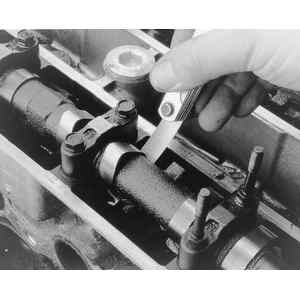The first step for any assembly job is to have a clean area in which
to work. Next, thoroughly clean all of the parts and components that
are to be assembled. Finally, place all of the components onto a suitable
work space and, if necessary, arrange the parts to their respective
positions.
- Lightly lubricate the valve stems and insert all of the valves into
the cylinder head. If possible, maintain their original locations.
- If equipped, install any valve spring shims which were removed.
- If equipped, install the new valve seals, keeping the following
in mind:
- If the valve seal presses over the guide, lightly lubricate
the outer guide surfaces.
- If the seal is an O-ring type, it is installed just after compressing
the spring but before the valve locks.
- Place the valve spring and retainer over the stem.
- Position the spring compressor tool and compress the spring.
- Assemble the valve locks to the stem.
- Relieve the spring pressure slowly and insure that neither valve
lock becomes dislodged by the retainer.
- Remove the spring compressor tool.
- Repeat Steps 2 through 8 until all of the springs have been installed.
To install the springs, retainers and valve locks on heads which have
these components recessed into the camshaft follower's bore, you will
need a small screwdriver-type tool, some clean white grease and a lot
of patience. You will also need the C-clamp style spring compressor
and the OHC tool used to disassemble the head.
- Lightly lubricate the valve stems and insert all of the valves into
the cylinder head. If possible, maintain their original locations.
- If equipped, install any valve spring shims which were removed.
- If equipped, install the new valve seals, keeping the following
in mind:
- If the valve seal presses over the guide, lightly lubricate
the outer guide surfaces.
- If the seal is an O-ring type, it is installed just after compressing
the spring but before the valve locks.
- Place the valve spring and retainer over the stem.
- Position the spring compressor and the OHC tool, then compress the
spring.
- Using a small screwdriver as a spatula, fill the valve stem side
of the lock with white grease. Use the excess grease on the screwdriver
to fasten the lock to the driver.
- Carefully install the valve lock, which is stuck to the end of the
screwdriver, to the valve stem then press on it with the screwdriver
until the grease squeezes out. The valve lock should now be stuck
to the stem.
- Repeat Steps 6 and 7 for the remaining valve lock.
- Relieve the spring pressure slowly and insure that neither valve
lock becomes dislodged by the retainer.
- Remove the spring compressor tool.
- Repeat Steps 2 through 10 until all of the springs have been installed.
- Install the followers, camshaft(s) and any other components that
were removed for disassembly.
| Fig. 1: Once assembled, check the valve clearance
and correct as needed

|
- Lightly lubricate the valve stems and insert all of the valves into
the cylinder head. If possible, maintain their original locations.
- If equipped, install any valve spring shims which were removed.
- If equipped, install the new valve seals, keeping the following
in mind:
- If the valve seal presses over the guide, lightly lubricate
the outer guide surfaces.
- If the seal is an O-ring type, it is installed just after compressing
the spring but before the valve locks.
- Place the valve spring and retainer over the stem.
- Position the spring compressor tool and compress the spring.
- Assemble the valve locks to the stem.
- Relieve the spring pressure slowly and insure that neither valve
lock becomes dislodged by the retainer.
- Remove the spring compressor tool.
- Repeat Steps 2 through 8 until all of the springs have been installed.
- Install the camshaft(s), rockers, shafts and any other components
that were removed for disassembly.

